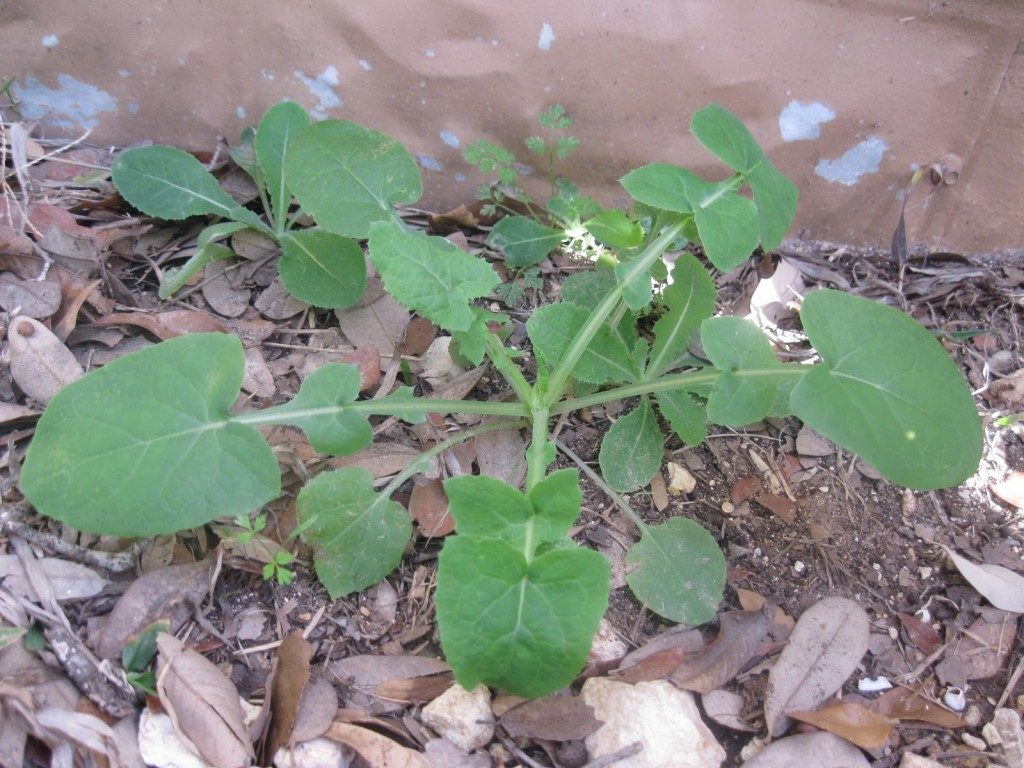
A young Common Sow Thistle, Sonchus oleraceus. Note the lobing early on. Photo by Mainstreaming Organics
Identifying sow thistles is fairly easy. What confuses the issue are wild lettuces and common names. Sow thistles are sprouting locally whereas wild lettuce has been up for a while. In four to six months they will both be puzzling my northern readers.
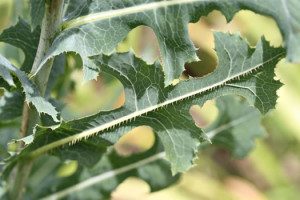
The Prickly Lettuce, Lactuca serriola, has extremely pronounced rib hairs. Photo by Name That Plant
When confronted with the question of whether it is a sow thistle or a wild lettuce look at the underside rib of several leaves near the bottom of the plant. Most wild lettuces in North America have a line of hair along the leaf mid-rib on the bottom side. (The Chicory Lettuce, Lactuca tatarica, is one exception.) Sow thistles also do not have a line of hair along the mid-rib. On wild lettuce that line of hair can be very sparse and soft to dense and stiff, depending upon the species. And with some species you have to look at several leaves to make sure there is or there is not a line of hair.
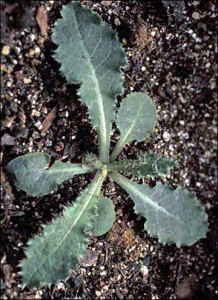
A young spiny sow thistle, Sonchus asper. It usually does not have lobes when young. Note the false spines on the leaf edge.
Also generally said sow thistles and wild lettuces have a V- or triangle-shaped leaf stem and white sap. Some wild lettuces have salmon-colored sap or white sap that turns salmon-colored in a few minutes. I do not know of any sow thistle that has salmon-colored sap. Blossom color is not much help. Both can have yellow blossoms though Lactuca floridana has blue blossoms as does the Chicory Lettuce mentioned above. Lactuca canadensis has yellow blossoms. They barely open on both L. floridana and L. canadensis.
As for common and local names there are sow thistles and true thistles and wild lettuces and sow thistle called wild lettuce. What common name you end up calling a plant is not important just as long as you know you’ve got the right plant (identified by its botanical name.) Beyond that the world got by a long time without botanists. What’s really important is not what you call a plant but whether it is edible or not and that you can identify it for certain. About the only time you have to bite the botanical bullet and cope with Dead Latin is with mushrooms, the majority of which do not have common names.
About elderberries… In the world of ripe elderberries you have blue and red… Yes, there is a rare white elderberry in Australia but for most of the world and most people their elderberry choices are limited blue or red… Red elderberries are strange in that the pulp is edible but the seeds are not. They must be processed out. The seeds of the red elderberry are not eaten because of cyanide-producing glycosides which are released upon digestion. So let’s move on the blue (or dark purple) elderberries.
Most, if not all, foraging books say ripe blue elderberries are edible raw.) Usually there is no qualifier after that statement. There should be. If you have a bowl of ripe blueberries (Vaccinium) how many do you eat? A teaspoonful? Handful, half a cup, even a cup? No doubt you can, and rarely anything comes of it. What of ripe blue elderberries? Yes, you can eat a few raw, ripe blue elderberries, seeds included. A few. But many of us who teach foraging get a lot of feedback. And what we hear is that more than a few raw ripe blue elderberries causes digestive problem, often mild nausea. This is not get sick and die stuff. Just not feeling well though it is worse the smaller and younger you are meaning kids should not eat many of them raw. I have my suspicions that ripe blue elderberries also have a bit of proto-cyanide in their seeds as well. Dried, cooked or made into wine they are certainly fine. But this is one instance where published reports might require some qualifications. Sample but go easy on ripe, raw blue elderberries. Besides they taste much better dried or prepared. Unripe green elderberries are toxic. Do not eat those. To read more about elderberries go here.
There will be Sliverthorn fruit soon because it’s been flowering lately. The distinctive shrub is one of my favorites because it fruits in February even up onto Georgia. Very sweet when totally ripe, the Silverthron also produces by percentage more lycopene than any other species. It’s a nice way to get your antioxidant. The edible seed, on the bitter side, has omega-3 fatty acids. I’m not sure why the species chooses that time of year to fruit but I suspect it has something to do with the winter solstice, the shortening days before it and the lengthening days after. Originally an ornamental, the Silverthorn has been naturalized in much of the southeastern United States. It is related to the Autumn Olive and the Russian Olive. To read about the Elaeagnus pungens click here.
The hunt is on for swinecress. This past week there was lots of rain then cold weather dipping into the 30’s. That’s perfect weather for this naughty winter mustard. It produces a vibrant green rosette that stands out among the drab winter lawns making it easy to spot even at a distance. There’s a small park locally where it can be reliably found, Lake Lilly in Maitland. When I give classes in town I can be seen there collecting a rosette or two to take with me. Swinecress, Coronopus didymus, is pungent, peppery, good though do know not all palates agree. It makes one wonder why it isn’t a commercial vegetable, a micro-mustard for local markets. Why is swinecress naughty? You’ll have to read that here.
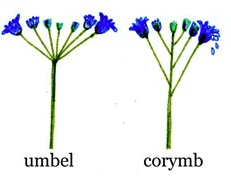 Botany Builder #29: Telling the difference between a simple umbrel and a corymb is as easy as it looks, once explained. It’s a blossom arrangement that can be critical to identification. An umbrel is a blossom in which each flower has a stem called a pedicel. All the pedicels originate from one central point. The word comes from the Dead Latin umbra meaning shade or shadow. It is also how an umbrella is orientated and why it is called an umbrella. There can be simple umbrels or compound umbrels. A corymb is a flat top blossom that can look similar. All it flowers are basically level but the pedicels are of different length. The lower pedicles are longer than the upper ones. Corymb (KOR-im) comes from the Greek word Korymbos which means flower cluster.
Botany Builder #29: Telling the difference between a simple umbrel and a corymb is as easy as it looks, once explained. It’s a blossom arrangement that can be critical to identification. An umbrel is a blossom in which each flower has a stem called a pedicel. All the pedicels originate from one central point. The word comes from the Dead Latin umbra meaning shade or shadow. It is also how an umbrella is orientated and why it is called an umbrella. There can be simple umbrels or compound umbrels. A corymb is a flat top blossom that can look similar. All it flowers are basically level but the pedicels are of different length. The lower pedicles are longer than the upper ones. Corymb (KOR-im) comes from the Greek word Korymbos which means flower cluster.
Because there are five Tuesdays this month there will be no newsletter December 31st. Time to take a mini-vacation from the keyboard.
A reminder the Florida Herbal Conference 2014 will be in Deland this coming February. Joanna Helms, RH (AHG), a sixth generation Floridian, will be among the teachers. She has been in clinical herbal practice for 16 years and is the founder of Mama Jo’s Sunshine Herbals in Indian Harbour Beach, Florida. For the third year in a row I will be leading weed walks at the herbal conference, a challenge in winter on dry ground. The walks are usually first thing in the morning when the air is cool, camp fires warm, and the herbal tea hot. Although it is the Florida Herbal Conference it draws teachers and students from all over North America.
Though your foraging may drop off during the winter it’s a great time to study wild edibles with my nine DVD set. Each DVDs has 15 videos for 135 in all. They make a great Christmas gift. Order today. Some of these videos are of better quality than my free ones on the Internet. They are the same videos but many people like to have their own copy. I burn and compile the sets myself so if you have any issues I handle them personally. There are no middle foragers. And I’m working on adding a tenth DVD. To learn more about the DVDs or to order them click here.
To donate to the Green Deane Newsletter or Website click here.

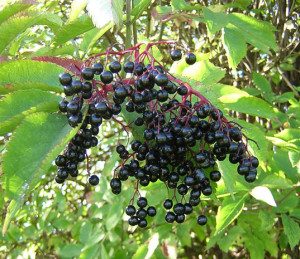
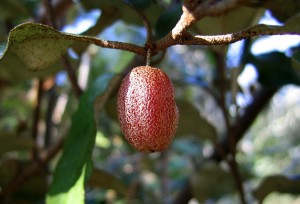




From Farouk, whose having issues getting posts to post:
Both the “Victorian Homes” story about the lady opposing removal of the assumed “Ash Tree” and that of Jenice’s grandmother of Owensboro Kentucky symbolise how humans through persistence and endurance struggle to keep this Earth a better place to enjoy living in. When I was a child (1950’s) , I expressed my opposition against the workmen of Kassala – eastern Sudan – municipality by crying all the time spent during cutting the “Douma Tree” – Hyphaene thebaica – for the sake of constructing a traffic road near my house. Through our childhood we used to eat the sweet hard crust of the dry fruit and suck the sugary liquid of the kernel of the unripe fruit ;that is plus the amusement we had in collecting the fruit. In case of the two stories above, the opposition was so strong that Nature has won the battle. However in my case week opposition made the wrong doers win. The lovely useful “Douma Tree” has gone and the people on both sides of the road are still suffering the traffic noise and carbon monoxide from the exhaust of old cars. Let me thank you for the useful Botany Builder #30 and please correct me if I’m wrong to apply to the leaves of two plants:”Cassava –Manihot esculenta” and the “Water Hyacinth –Eichhornia crassipes” both I keep in my garden.
No doubt I could have identified the plants named in this issue of Eattheweeds had I still been living in the winter of Southampton – UK. Now I am back in my tropical country where there is no need for much fat to burn to keep myself warm. Here it is already warm ; but dry days with bright sun shine and spells of rather cold weather will be expected to continue till the beginning of March of next year. Now also almost all types of grass and herbs have withered – good fodder – and seeds tend to become dormant for the purpose of next generation by the coming rainy season (may be start of June or July ). Thank you for the Botany builder #29 . I’ve added to my vocabulary more useful meanings. Best wishes from my grandson, the future forager, Yusuf.